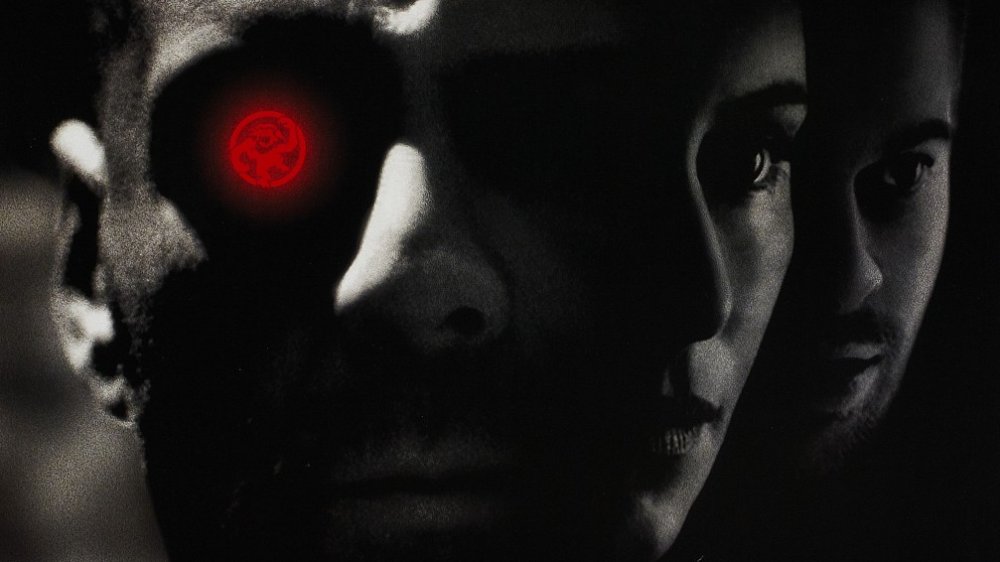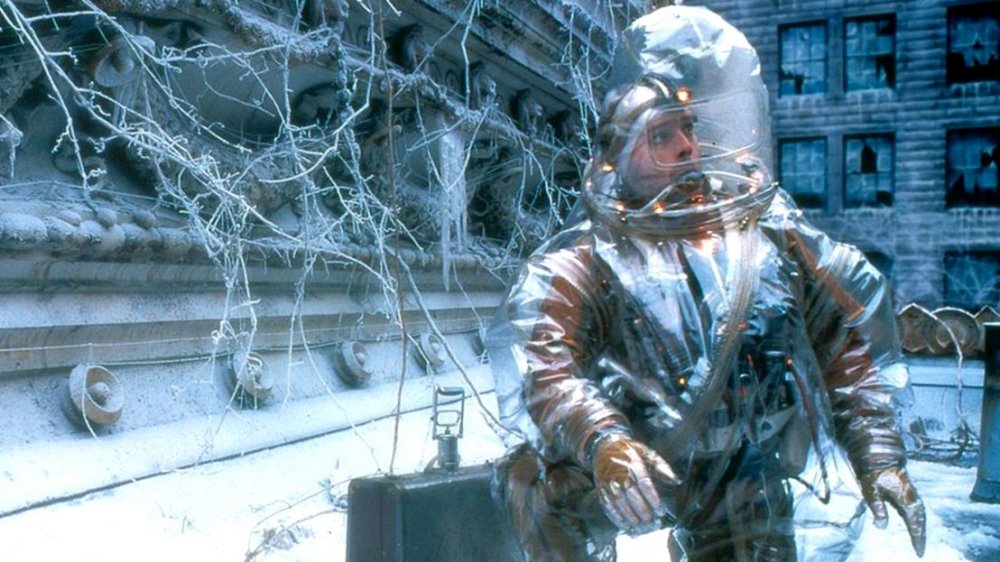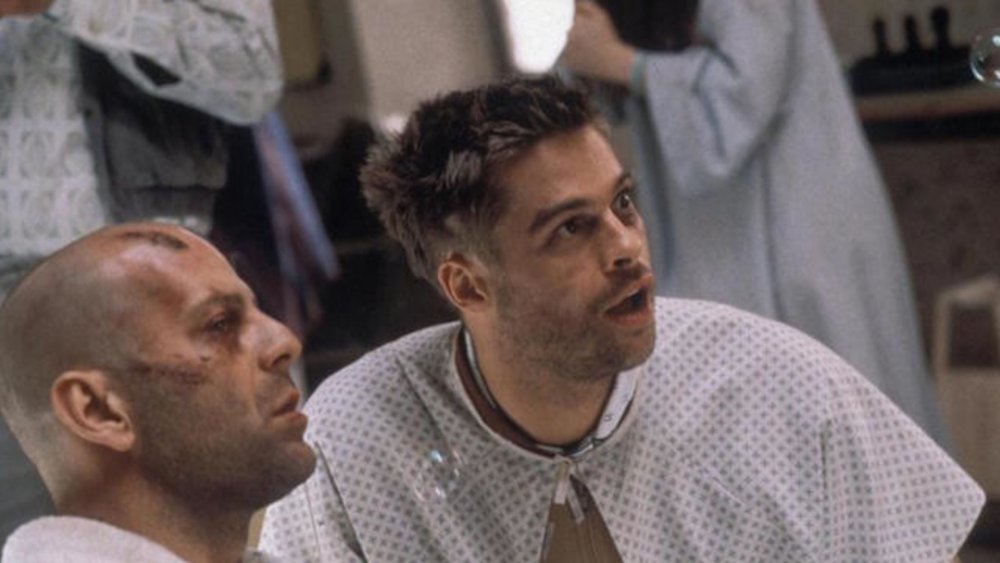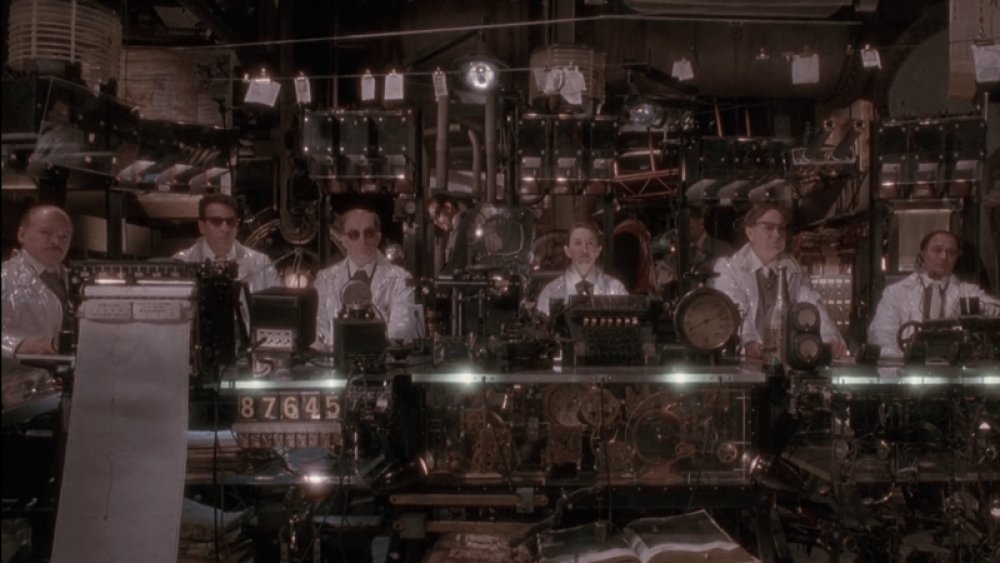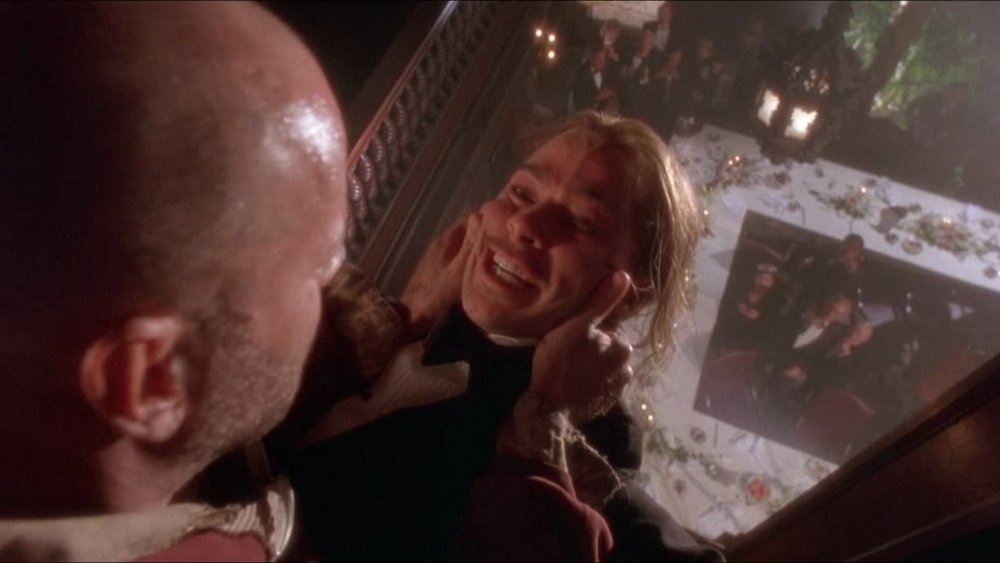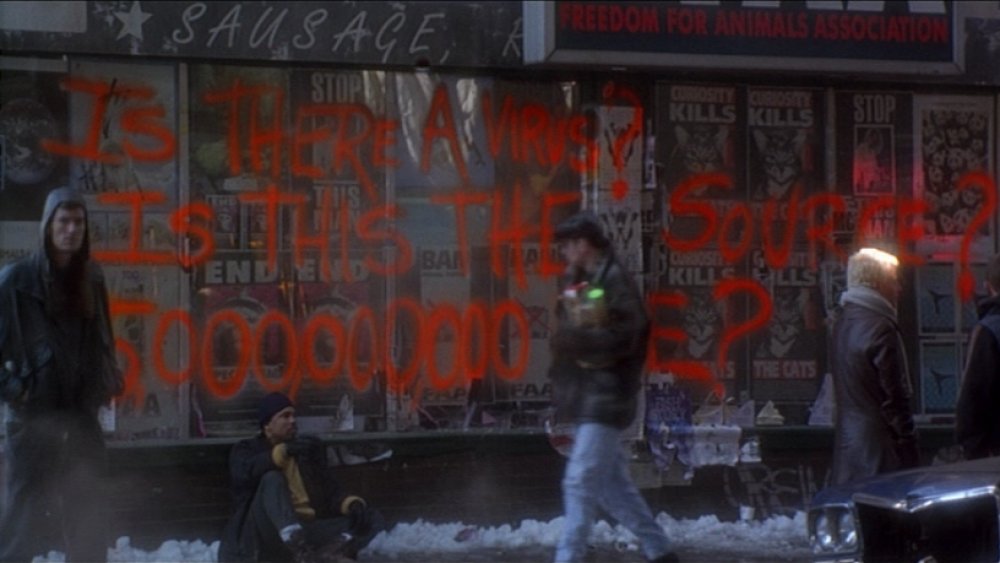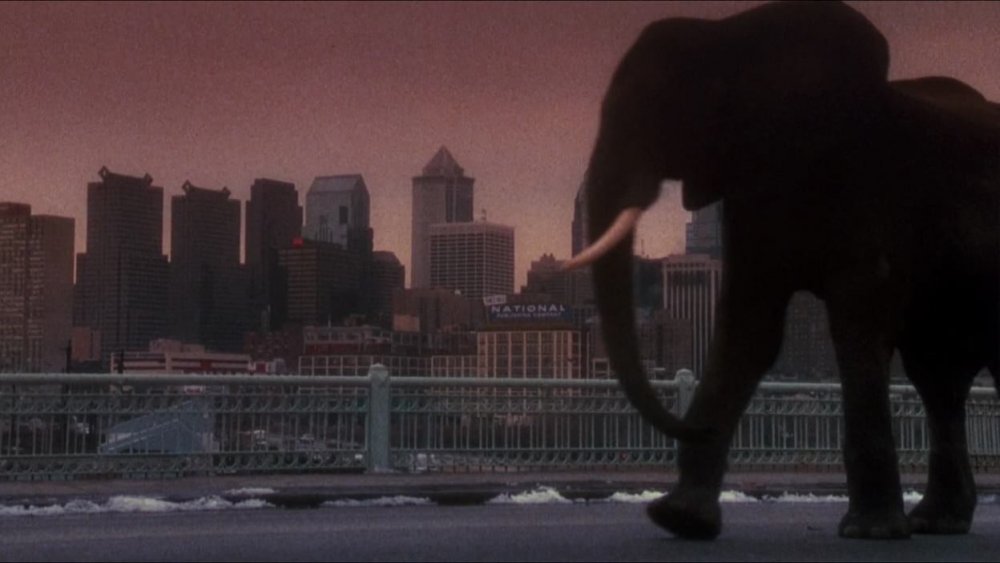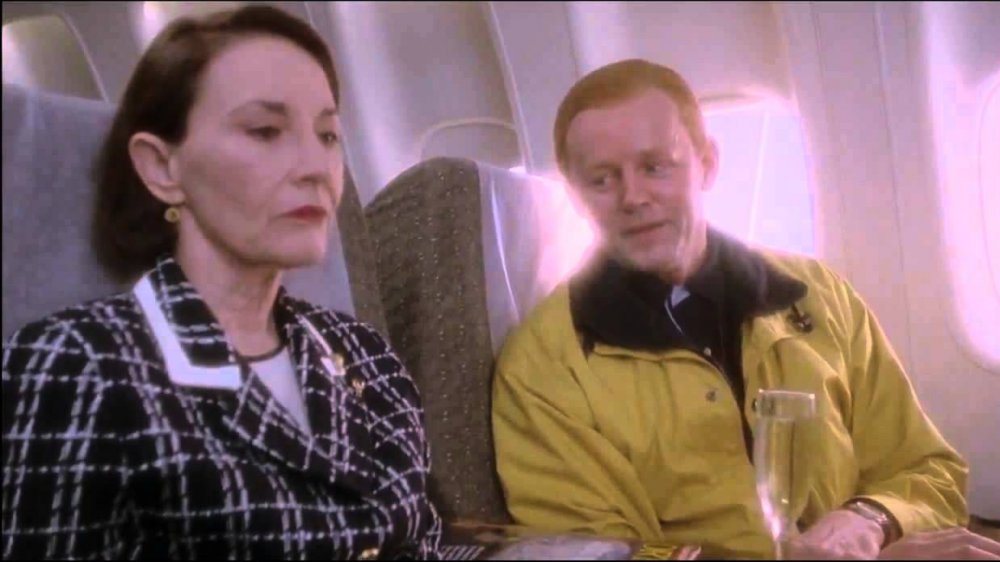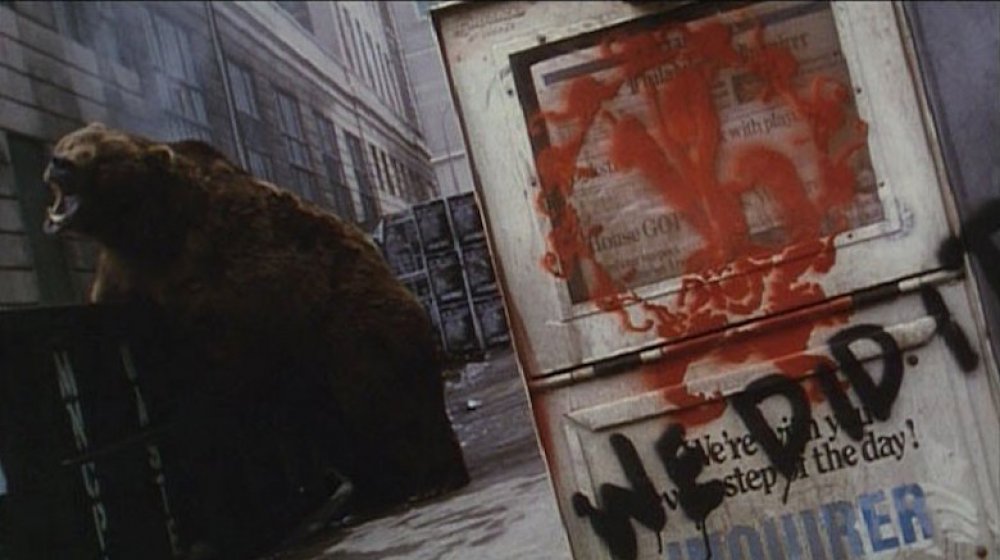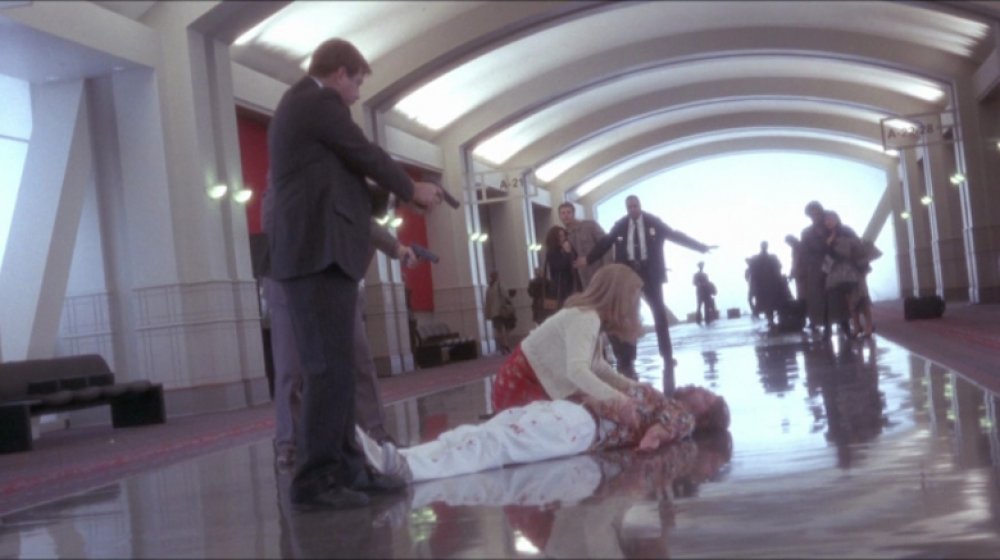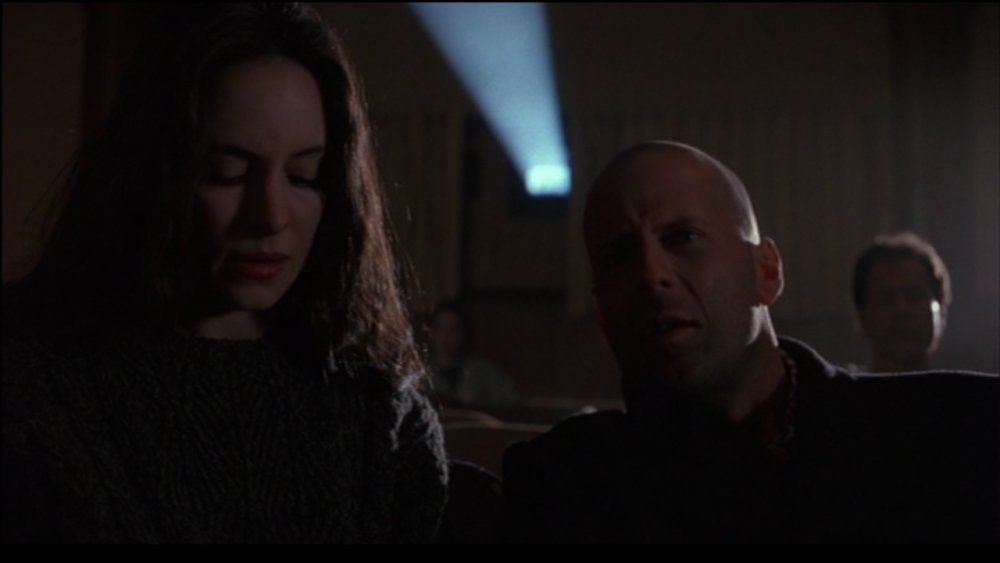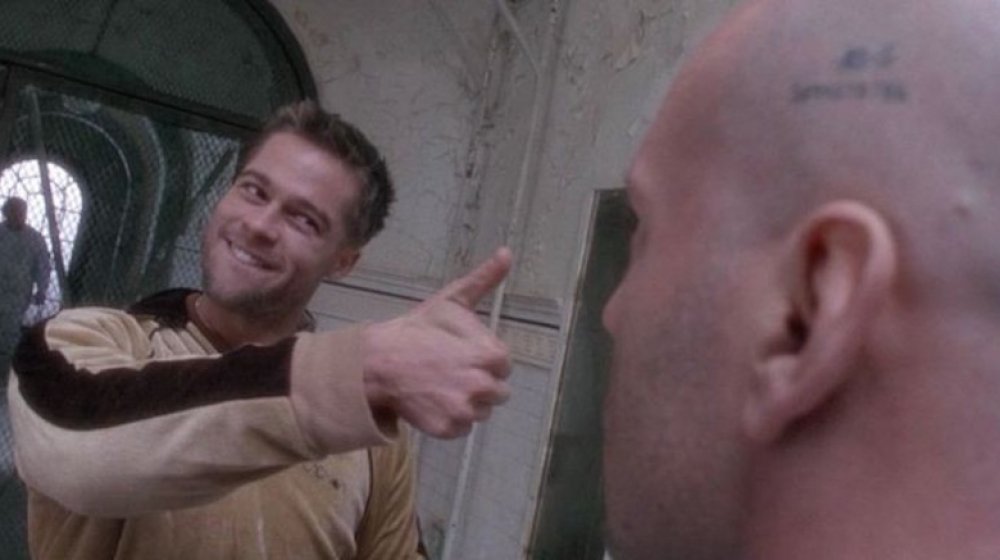The Ending Of 12 Monkeys Explained
Inspired by Chris Marker's short film La Jetee, Terry Gilliam's 12 Monkeys chronicles the effort to trace a virulent pandemic to its source, in an attempt to rewrite global history. Flipping back and forth between 1990, 1996, and 2035, Bruce Willis stars as James Cole, a prisoner turned time traveler. He is sent to the past to help a panel of scientists uncover the moment the virus mutated, an act that will hopefully allow the human population of 2035 to recover.
Written by Janet and David Peoples, 12 Monkeys also features Brad Pitt as unstable Jeffrey Goines, scoring the actor his first Oscar nomination for best supporting actor, as well as cinema legend Christopher Plummer playing his father Leland. Madeline Stowe plays Dr. Kathryn Railly, a skeptical psychiatrist whose story becomes inextricably tangled with both James and Jeffrey's in their search for information about what, exactly, ended the world. Accompanied by a frantic string and accordion score that's as kinetic as the movie's action, 12 Monkeys was well ahead of its time in predicting a global pandemic that would change life on earth irrevocably. With all its massive divergences and time jumps, however, it can be a little hard to parse. This is the ending of 12 Monkeys explained.
James Cole "volunteers" in 2035
A viral plague has decimated the world, sending humans underground for their own protection. James Cole, a denizen of this dystopia, wakes up in his prison cell deep in the earth. He's had the dream again, about the little boy watching a man gunned down at the airport. José in the cell next to Cole's tells him his name was called as a "volunteer" to go above ground and collect data. "I didn't volunteer," Cole insists, as the prison guards suit him up in protective plastic. A voice over the PA reminds him that if there are any tears in the gear, he will not be allowed re-entry.
Cole emerges from a manhole into Philadelphia. The city is populated only by animals — and not just the typical Pennsylvania wildlife. A lion paces the ledge of a building while a grizzly bear reminds Cole he's at the bottom of the food chain now. Cole collects a beetle and a spider as he surveys a once-busy department store grown decrepit from decades of abandonment.
Back underground, a panel of scientists invite Cole into a special information-gathering project. They explain that they will send him back in time to try and pinpoint who was responsible for spreading the virus so they can change the future. Cole will get a full pardon if he completes the mission. He consents.
The wrong year
Cole is supposed to arrive in October 1996, but something goes wrong, and he is deposited in Baltimore, April 1990. After an altercation with cops, he is institutionalized by Dr. Kathryn Railly. She feels an inexplicable connection to him, even as he insists he's from the future. Cole had been given a phone number to update the scientists with his findings, but when Railly gets him permission to call it, the person who answers is a mom dealing with her unruly kids who knows nothing about him. Cole surmises that since he has been sent to the wrong year, the number isn't correct yet. Still committed to collecting data but lacking his vials, he swallows a spider for transport.
Cole meets Jeffrey Goines in the institution, whose father is a well-known virologist. While Jeffrey might be classified as mentally ill, his rantings make a lot of sense, especially as he is particularly concerned with germs. "Maybe the human race deserves to be wiped out," Cole says to Jeffrey, who seems intrigued. Jeffrey helps Cole escape, but because he's on so many drugs, the attempt fails. Cole mysteriously disappears from his locked cell, the shackles still bound to the bed.
Cole returns to 2035 for the first time
Disoriented from the drugs he'd been given in the asylum in 1990 as well as from time traveling, Cole wakes in 2035 to a raspy voice calling him Bob, trying to get information from him about what he'd seen. When Cole is brought to the panel of scientists for debriefing, he insists that they sent him to the wrong time. However, they play him a tape from 1996 of a woman's voice talking about the "Army of the 12 Monkeys" being responsible for the outbreak, which further scrambles Cole's brain. He was, apparently, never in 1990 at all.
This is the point at which Cole first begins to doubt his sanity. Cole's dream of the little boy in the airport changes slightly as well, with Jeffrey Goines appearing as the red-haired man being chased. The scientists show Cole a number of photographs involving what they think might have to do with the pandemic, and he recognizes Jeffrey from a picture of an animal rights protest. When the scientists discover Cole had actually made contact with the man they now believe to be responsible for the outbreak, the scientists send him back to 1996 to intercept Jeffrey and the virus before it mutates.
Cole travels to 1996 from 2035
Cole is sent into the past once more, ending up waylaid in France in October 1917, right in the middle of WWI. Cole is shot as he sees his 2035 neighbor, José, who is also badly injured.
In November 1996, it's been six years since Railly's encounter with James Cole. The event changed her. She's been researching people in history who claimed to be from the future and tried to alter the course of history, but were disbelieved. Her resulting book is called The Doomsday Syndrome, and it includes an anecdote about José, even though she doesn't yet know how he and Cole are connected. After her talk, Railly signs copies of her book while a red-headed man peppers Railly with all kinds of strange comments about a virus. She laughs him off, even though he has a smug cruelty about him that seems dangerous.
Finally in the right time, Cole kidnaps Dr. Railly and forces her to drive him to Philadelphia where he is planning to confront the Army of the 12 Monkeys. Once they arrive, he sees the 12 Monkeys symbol like breadcrumbs, and follows it to an abandoned theater where he and Railly are assaulted. Cole kills the attackers and they continue to search, eventually recognizing a storefront that appeared in photos in 2035. Cole finds the 12 Monkeys headquarters and learns Jeffrey has split with the group in favor of more militant animal rights action.
Cole and Jeffrey meet again in 1996
The members of the 12 Monkeys tell Cole that Jeffrey will be at a benefit gala at his father's mansion, so Jeffrey forces Railly to drive him to Leland Goines' estate. On the way, Cole hears a story on the radio about a little boy trapped in a well and mentions remembering the story from when he was a kid. He remembers how upset everyone was when it turned out to be a hoax — the little boy had been hiding in a barn nearby. Railly still doesn't believe he's from the future and suggests that he's sliding deeper into a delusional Cassandra narrative.
At the Goines manor, Cole confronts Jeffrey, demanding access to the virus. Jeffrey appears to have sold out and now works with his father, even though he continues to test on animals. Jeffrey taunts Cole with different memories of what happened at the asylum. He also appears to take credit for the virus, but says it was Cole who gave him the idea when they were institutionalized together. Cole's sanity begins slipping even further as he starts thinking how amazing it would be if he really was crazy and the world wasn't in imminent danger. As Cole splashes about in a stream, delighted by the thought that there is no virus, he disappears into the future once again.
Who is the Army of the 12 Monkeys?
At this point, the film begins flipping rapidly between 2035 and 1996. In 2035, Cole receives a full pardon for discovering the source of the virus. In 1996, Railly finds photographic evidence that Cole is who he says he is, and that he's probably correct about the virus. Like Cole, Railly now believes that Jeffrey Goines and his army are to blame. She contacts Dr. Goines to warn him about his son possibly stealing and weaponizing a virus. Dr Goines decides to ramp up security, but Dr. Goines' assistant Dr. Peters turns out to be the virus-obsessed red-headed man who hassled Railly after her talk.
In 1996, Railly tags the Army of 12 Monkeys headquarters with a message about whether it's the initial site of the virus, and runs into Cole again. It's not clear how Cole got there — he doubts his sanity entirely by this point. In a poetic reversal, it is now Dr. Railly trying to convince Cole he really is from the future. After a series of violent encounters in a motel, Cole removes his molars in the off chance they might be tracking devices.
Jeffrey talks to his 12 Monkey comrades about how Railly is crazy and thinks he's trying to spread a virus. He let's her believe it so she'll be distracted from uncovering their real plan.
"We did it!"
Now that Cole thinks he can't be tracked, he decides to stay in 1996. Because Railly believes Cole now, she calls the number Cole remembered from the 1990 visit, and leaves the message Cole heard when he first returned to 2035.
Cole is wanted for murder, so Railly organizes disguises, including a blonde wig for her. Cole recognizes her from his airport dream. On their way to the airport to escape to Key West, they learn animal activists have released all the animals from the Philadelphia Zoo and locked Dr. Goines in one of the gorilla cages. The Army of the 12 Monkeys was only about animal liberation after all, and had nothing to do with the virus. Railly thinks everything will be okay.
At the Philadelphia airport, Cole continues having flashbacks to his dream. He calls the future number again and tells them the 12 Monkeys had nothing to do with the virus. All the while, as Railly buys their tickets, apocalypse nut Dr. Peters is in line behind her with a metal briefcase plastered with travel stickers, same as Cole's "dream". Inside are vials of the virus. A security guard asks him to open one, which he does. This is the first point of contagion — and Dr. Peters has a round-the-world ticket including San Francisco, New Orleans, Rio, Rome, Kinshasa, Karachi, Bangkok, and Peking. All of these cities are the first virus hotspots known in 2035.
"The Florida Keys are waiting for you"
As Cole and Kathryn prepare to board, José shows up and tells Cole they got the message about the 12 Monkeys not being the virus source. In the meantime, Railly has recognized Dr. Peters and his case. She tries to cause a scene to stop him, but he gets away. In the process of trying to shoot Peters, the police gun Cole down. The audience finally learns Cole's airport dream wasn't a dream at all: We see young Cole witness his own murder. Railly makes eye contact with the boy and smiles, almost in recognition.
Dr. Peters, out of breath but clearly triumphant, takes his seat in first class and stows his murderous case. His seatmate introduces herself as Jones, and we recognize her from the panel of scientists in 2035. "I'm in insurance," she tells him as the movie ends.
The ambiguous ending begs many questions. For all of their efforts, was the pathogen still released at the airport in 1996 in Philadelphia, or will 2035 go back and amend this too? Was Jones sent back from the future, or is it a coincidence she ends up on the plane with the virus' source? Was Jones going to do something to Dr. Peters during the flight to ensure he can't release the virus anywhere else? No clue. What we do know is that James Cole's life was a tragic loop, centered around his own death.
Animal rights are a key factor in 12 Monkeys' plot twist
In real life, pandemics are often caused by environmental factors like deforestation. This event forces carrier animals and all their viral illnesses into human territory, as seen in the true-to-life Contagion. In 12 Monkeys, however, everyone assumes the Army of the 12 Monkeys released the virus. They hate humanity, right? And weren't they there at the right time? These assumptions are, of course, revealed to be foolish and deadly.
It is a human man with mass murder on his mind who weaponizes and releases this particular virus into the world. Ironically, the freed Philadelphia Zoo animals released into a foreign environment have absolutely nothing to do with the virus' spread. It's also fascinating to note that unlike other pandemic movies, 12 Monkeys does not focus on what the virus does at all. A strange fever erupts in its victims, who drop dead quickly. We never see anyone suffering or dying from the virus, we only see its aftermath.
The past can't be changed, we can only prevent for the future
In spite of the ambiguity in its ending, a key message of 12 Monkeys is that the past is fixed and can't actually be changed. We know that Cole witnesses his own death as a child, and always ends up at this point in 1996. Unlike other time travel movies where multiple visits to the past change that very past and its resultant future (we're looking at you, Avengers: Endgame), 12 Monkeys' past remains static.
This is a powerful message that encourages prevention in the present, instead of spending time and resources arguing over the past. Another terrifying message is also extremely true to real life: Contagion is inevitable when a deadly pathogen gets into the human population. Containment needs to be the first step, not waiting for it to run its course and then trying to rewrite history for a different outcome.
12 Monkeys is about trauma and memory
The inclusion of Alfred Hitchcock's Vertigo when Cole and Railly disguise themselves for their escape is an important detail. Vertigo features an elaborate plot that hinges on a doppelgänger who helps cover up a murder. Scottie (James Stewart) has extreme vertigo, and when his lover Madeline Elster (Kim Novak) threatens suicide by jumping, he is unable to stop her. Haunted with guilt, Scottie one day meets a woman who looks like his love, but with different hair. It turns out Judy Barton (also played by Novak) was a lookalike hired by Madeline's husband to fake her suicide, since he had already murdered his wife. Judy dies just as she pretended Maddy did: by falling.
Vertigo's themes of doubles and doppelgängers relates to 12 Monkeys on multiple levels, since there are several versions of Cole, Railly, Jose, and others running around multiple timelines. Vertigo is also about how trauma affects memory, and memory can affect trauma, just as in the case of 12 Monkeys' James Cole who witnesses his own death. "Here I was born. And here I died," Madeline says in Vertigo within 12 Monkeys, pointing at the rings marking the years of a fallen redwood in Muir Woods. The opening and closing of 12 Monkeys uses a similar narrative feature with James Cole's story.
12 Monkeys weirdly predicted future movies
"There's the television," Jeffrey Goines rants, "It's all right there — all right there. Look, listen, kneel, pray. Commercials! We're not productive anymore. We don't make things anymore. It's all automated. What are we for then? We're consumers. Yeah. Okay, okay. Buy a lot of stuff, you're a good citizen. But if you don't buy a lot of stuff, if you don't, what are you then, I ask you? What? Mentally ill."
Fans of Brad Pitt's Fight Club will immediately recognize Jeffrey's sentiments as Tyler Durden's own anti-capitalist code, summed up in Durden's line, "The things you own end up owning you." But the strange Fight Club connection doesn't stop there. Jeffrey Goines talks about his father being God, which is another huge theme in Fight Club. At the end of 12 Monkeys, Jones says she is in insurance. The Narrator (Edward Norton) of Fight Club is in insurance as well, and he often tells people this when sitting on airplanes. Fight Club even has scenes where Tyler Durden's crew releases animals onto unsuspecting citizens.
But this isn't the only weird connection to a future movie. After murdering two attackers, Cole says to Kathryn Railly, "all I see are dead people." Years later, Bruce Willis would star in The Sixth Sense, the movie that made "I see dead people" into one modern cinema's best-known catchphrases.
